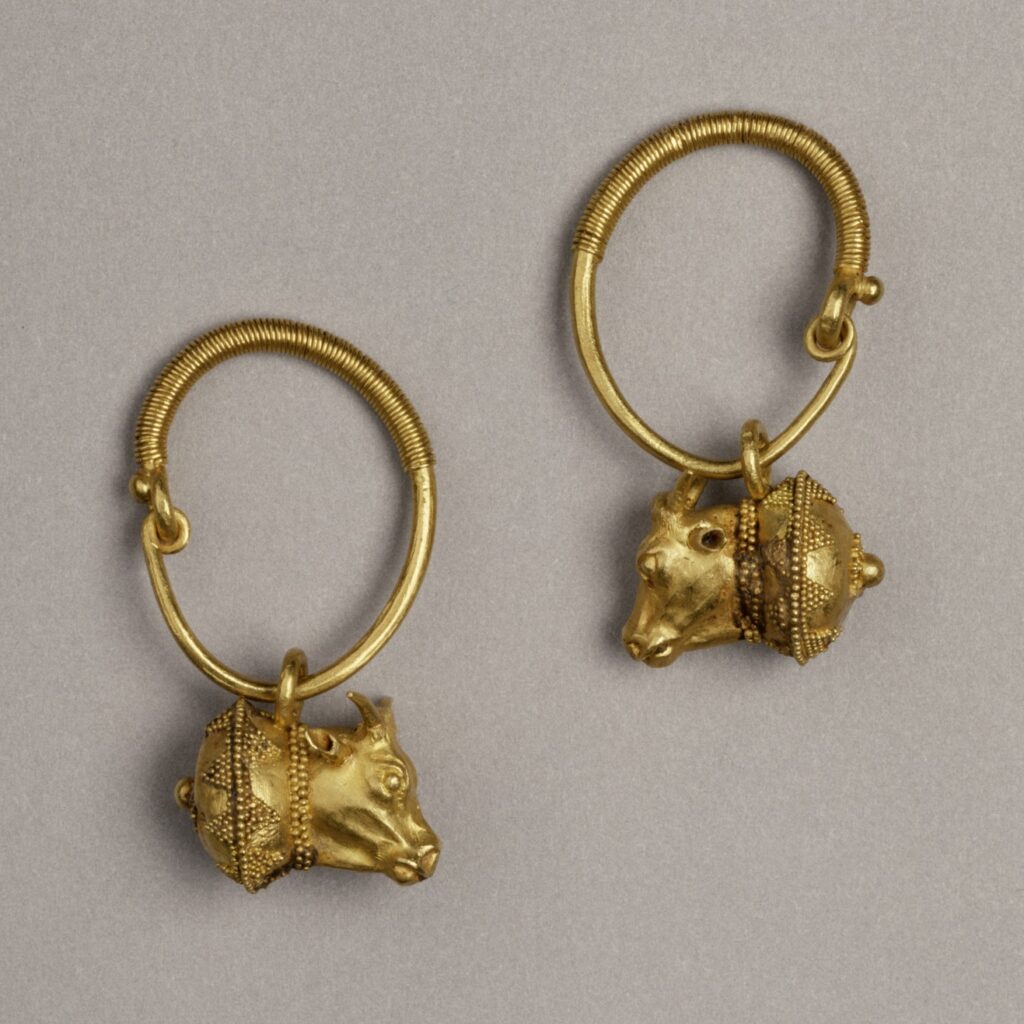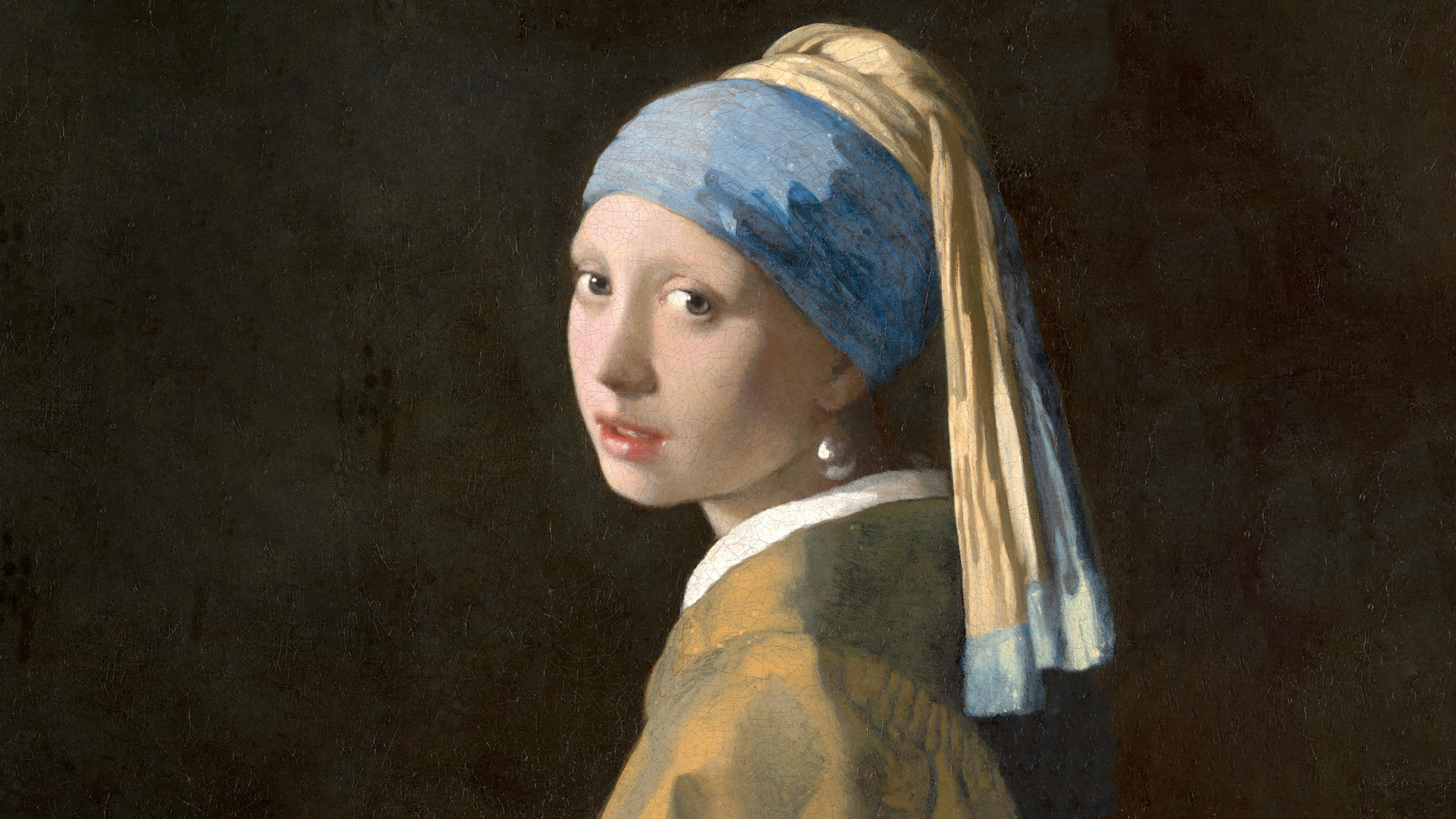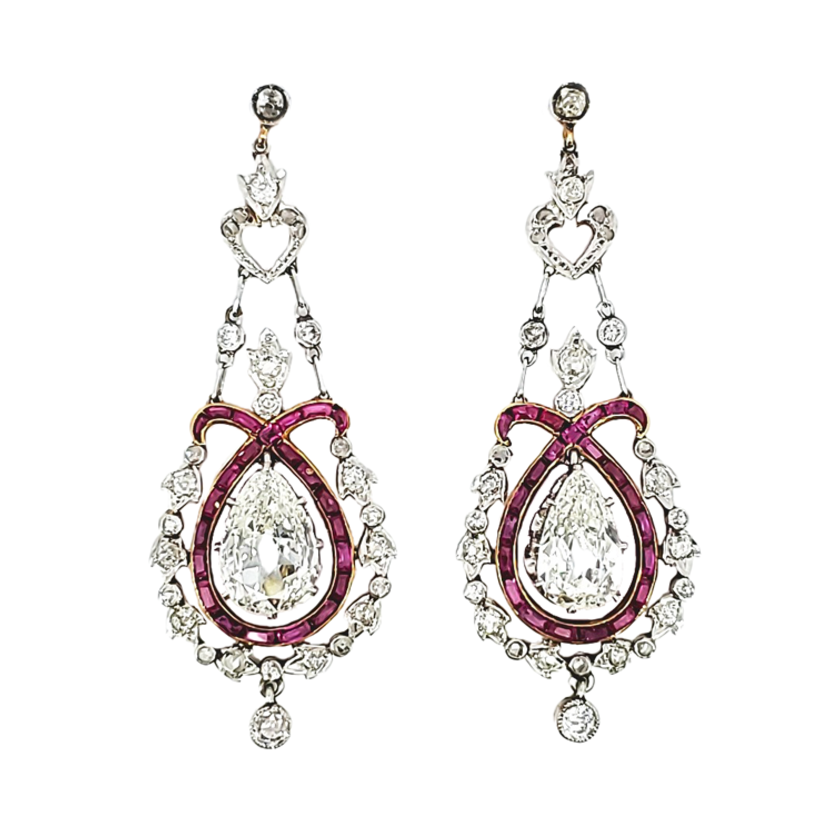What do King Tut, Shakespeare and cats have in common? They all wore earrings. Those sparkling baubles that we use to adorn our ears have been in (mostly in) and out of fashion for approximately the past 5000 years. Earrings have been worn by men, women and children from all walks of life and all geographic locations. Historians don’t have an exact moment or event that shows when the first earrings were worn, but there is archeological evidence that earrings have been worn since the time of the ancient Sumerians and Egyptians, with earrings being found in tombs from both cultures. The oldest known earrings, a large gold hoop style, were found in the tomb of Mesopotamian Queen Puabi, dating back to 2600 – 2450 BCE.
Earrings of the Ancients

Earrings worn in the ancient world, were status symbols and expressions of cultural identity, but they were also worn as talisman for protection. Some ancient societies believed that evil spirits could enter the body through its various openings, including the ears, so earrings were worn as defense against these intruders. The Egyptians made ornate earrings of precious metals and gemstones sometimes with symbols associated with their Gods and Goddesses, believing that the jewel could fend off evil spirits and draw good fortune. They also believed that the gemstones used in the earrings added another layer of protection for the one wearing the earrings.
When King Tutankhamen’s tomb was opened in 1923, it was notable that he appeared to have pierced ears. His burial mask also had ear piercings. Allegedly, his wife, Queen Neferititi, wore two earrings in each ear as a display of status. Earrings were found in many tombs of that time, often used in rituals and for funerals. Earring styles included gold hoops, studs and dangles, sometimes decorated with turquoise, lapis or jasper. Interestingly, in Egypt, where cats are considered sacred, paintings and statues sometimes portray felines wearing earrings.
Greek and Roman, men and women, wore elaborate earrings featuring animals, mythological creatures and geometric patterns showing the skill of the artisans who made them, cultural values and social standing. The type of earring worn, was also an indicator of your place in society. In Greece, earrings were worn in various religious ceremonies, often symbolizing offerings to the Goddess Aphrodite. Crescent shaped earrings were a nod to the moon Goddess Selene and pearls were a nod to Poseidon, God of the seas, while cows were sacred to the Goddess Hera, patron of marriage, and bulls were sacred to her husband, the God Zeus.
Many of the earrings worn during this time were a type of hoop. Either plain metal or adorned with gems, for the wealthy. For those with less resources shell, bone, stone, even animal teeth were used. During this era, doctors believed that certain gems set in earrings could get rid of headaches and improve eyesight. The Romans believed that wearing earrings fostered good health. Towards the end of the Roman era, earrings became more of an accessory for women, who were expected to wear them to show the family’s station in society.
Medieval Earrings

By the time the Middle Ages rolled around, earrings were not worn much in Europe for a couple of reasons. Fashion changed. Hairstyles covered the ears and large headpieces, such as veils and hoods, were worn, so earrings would not be visible. Perhaps more importantly, the Church frowned upon ear piercing, even forbidding it based on the belief that it violated the image of God and that it was a sin to modify the body by piercing. However, there were still some people who wore earrings and those jewels were often very ornate. The upper echelons of society of course wore precious metals and gemstones, while commoners wore brass or pewter. Thieves and the lower classes were wearing the most earrings.
With the dawning of the Renaissance, came a renewed interest in earrings. Hairstyles changed revealing the ears, which helped spur their popularity. During the Renaissance, pearl earrings, especially baroque pearls, were particularly favored. Renaissance paintings often show women prominently wearing earrings, a show of wealth, social status and beauty. Men began to wear earrings more obviously at this time. Playwright William Shakespeare, adventurer Sir Walter Raleigh and admiral Sir Francis Drake, all wore earrings. There is a painting of Raleigh wearing a large pearl drop earring in the North Carolina Museum of History.
Sailors have traditionally been depicted wearing a gold hoop earring, which was more than just an adornment. For those on the high seas, these ear baubles had multiple meanings. Many sailors wore a gold hoop earring in case they died at sea, the earring could be sold to pay for a funeral. Some sailors engraved their home port on the earring, so they could be returned to their loved ones. Known to be a rather superstitious bunch, sailors believed that wearing an earring was protection from getting sea sick, they also thought that wearing an earring would improve eyesight and prevent drowning.
Georgian Grandeur
By the time the 1700s and the Georgian era arrived, earrings became an important jewelry item for stylish women. Updo’s were the chicest hairstyle and ears were on full display. Girandole earrings, which were large elaborate affairs comprised of a gem on the earlobe with three large drops suspended from a decorative element, were the height of fashion, however due to their size and weight these earrings were hard to wear and eventually faded from fashion. Pendloque earrings, with a jewel on the lobe, dangling a bow and a large pear shaped drop where also fashionista approved.
When Queen Victoria took the throne in 1837, earrings were on the back burner of fashion as hairstyles once again covered the ears. Petite diamond earrings, known as doremuse, were worn while sleeping to prevent ear piercings from closing. By the mid 1800s earrings were fully back in style with long drops, dangles and archeological revival styles being among the most important designs. Earrings continued to be worn into the Edwardian era, but they were not as flamboyant as earlier years, in part because tiaras and hair accessories were frequently worn, so earrings were not as necessary, however long diamond or diamond and pearl earrings all set in platinum made a style statement.
Earrings in the 20th Century
A big shift came about at the end of the 1800s and early 1900s in earring fashion. The screwback was invented to attach an earring to the lobe, eliminating the need for pierced ears. The practice of ear piercing began to feel outdated and even barbaric. Earring were popular all through the early 1900s with long earrings the epitome of chic in the 1920s and scrolled earrings that were closer to the face becoming more popular in the 1930s. Earrings stayed smaller and were mostly gold with small gems during the 1940s when World War II brought about rationing and other challenges to jewelry making. The 1950s saw two things happen to earrings. During the day jewelry was kept very minimal and pearl stud earrings were in every woman’s jewelry box. But when the sun went down, the diamonds came out as formal dressing for evening was trending.
The 1960s gave birth to the counter culture movement and women began piercing their ears again, especially college students. Ear piercing was seen as an act of rebellion against the more structured attitudes and styles of the 1950s. Hoops and long dangling earrings that were big and bold were on trend, morphing into the 1970s when hoops really took centerstage. When the 1980s came about large doorknocker and button earring styles dominated. It was also the decade when both men and women began adding multiple piercings to their ears, which meant wearing several earrings at the same time, a trend that has continued.
In today’s world of pretty much anything goes in fashion, there are myriad styles of earrings that you can choose to complement an outfit or express your personality and if you look carefully you may find a connection between our modern designs and the vintage styles of past years.
Top of Page: Girl with a Pearl Earring, by Johannes Vermeer, oil on canvas, circa 1665, Public Domain, Courtesy WikiCommons.
Authored by Amber Michelle


